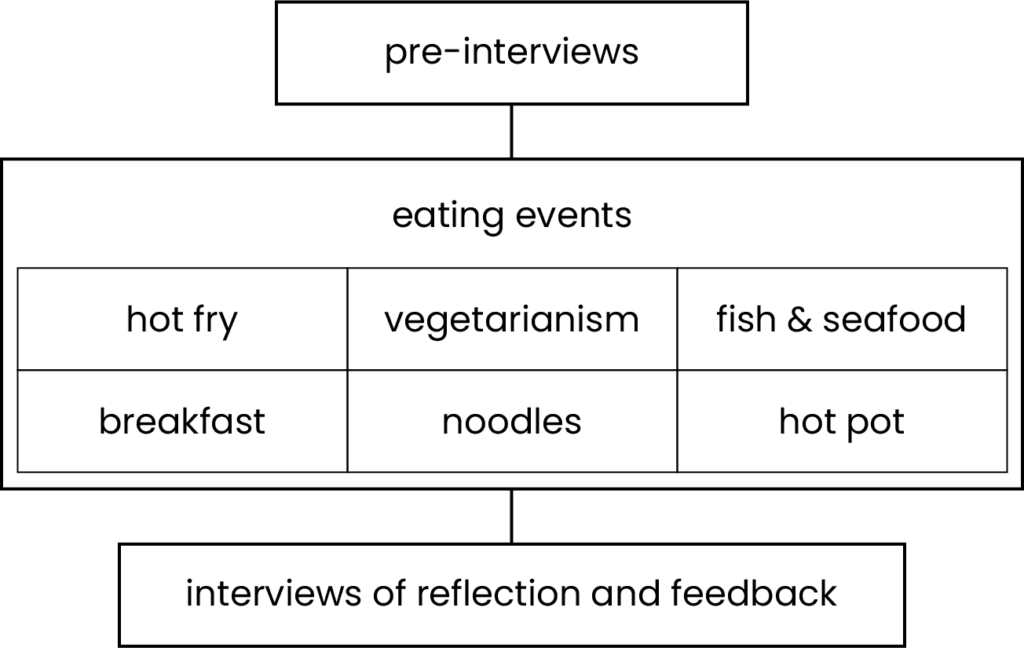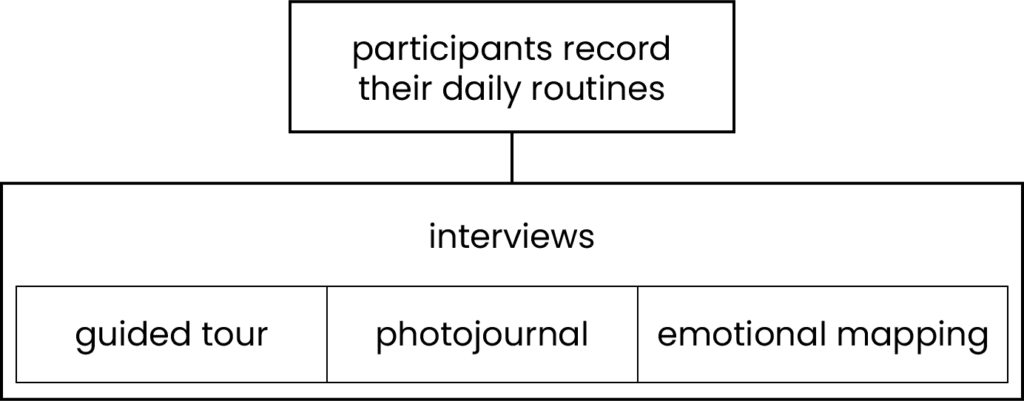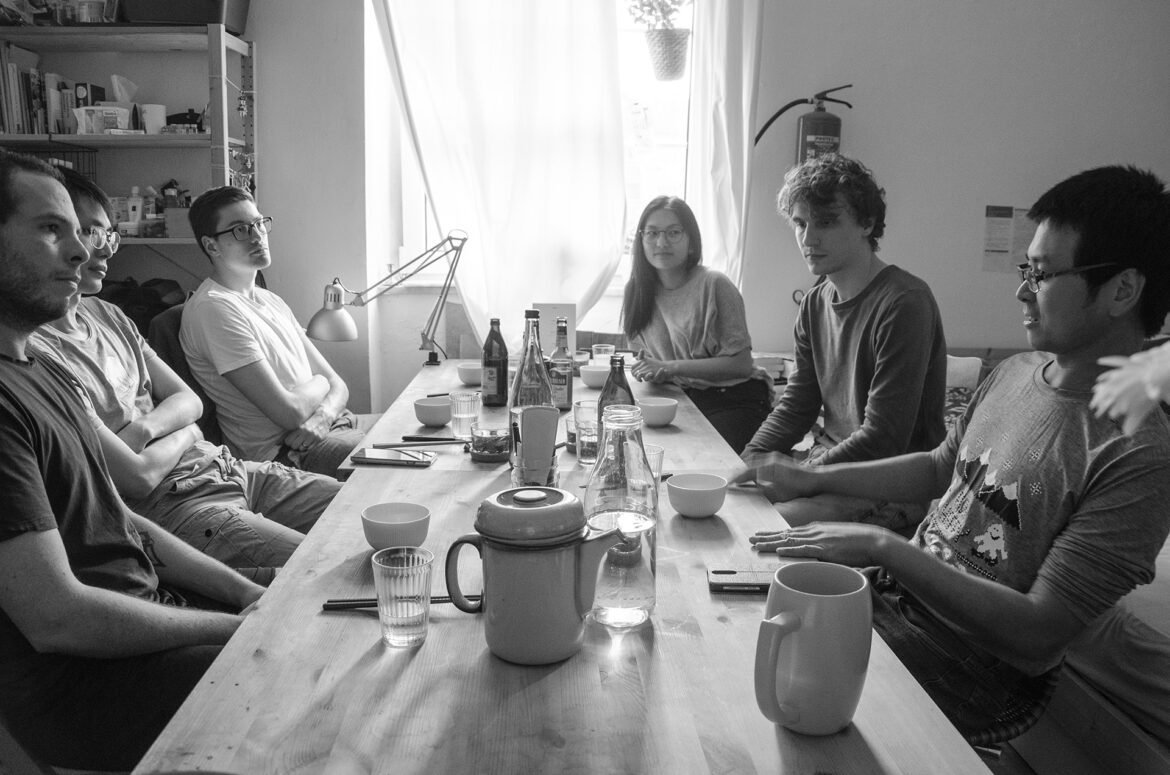
“
烹飪是一門語言,透過這門語言,無意間將社會結構翻譯──或者同樣地,無意間揭露自身矛盾。 … the cooking of a society is a language in which it unconsciously translates its structure – or else resigns itself, still unconsciously, to revealing its contradictions.
Claude Lévi-Strauss. 2012. The Culinary Triangle.
透過飲食體驗設計探討跨文化溝通
「A Food Journey from Taiwan to Germany」是一個飲食設計專案,延伸自 Yen 的碩士論文《Cross-Cultural Communication through Eating Experience Design》。
本研究探討食物如何透過飲食體驗傳遞文化訊息,連結台灣與德國群體。研究結果提供了一種設計解決方案,促進兩個文化群體間的有效溝通,並催化雙向的同理與理解。
Research on cross-cultural communication through eating experience design
A Food Journey from Taiwan to Germany is an eating design project developed from Yen’s master’s thesis, Cross-Cultural Communication through Eating Experience Design.
This research explores how food conveys cultural messages through eating experiences between Taiwanese and German groups. The findings offer a design solution for effective cross-cultural communication, fostering empathy and understanding between the two cultural groups.

研究聚焦於兩個族群——德國人與台灣人,並分為兩個階段:「從台灣到德國」和「從德國到台灣」。
在第一階段,德國人作為溝通過程的接收者,在民族飲食環境中解讀台灣人所傳遞的的文化訊息,透過一系列問題與台灣飲食模擬情境帶領體驗。
The research focused on two ethnic groups—Germans and Taiwanese—and was developed in two phases: Taiwan to Germans and Germany to Taiwanese.
In the first phase, Germans acted as the receivers in the communication process, decoding the cultural messages embedded in an ethnic eating environment created by Taiwanese. A series of questions and curated Taiwan eating scenarios were designed to guide their experience.

第二階段針對三位在德國居住時間長短不一的台灣人進行質性訪談。他們的經驗與德國人的經驗在德國交匯,塑造一個能夠促成理解的重疊空間。
訪談的目的在於探討台灣人在德國的適應過程,以及食物在其中所扮演的角色。
In the second phase, qualitative interviews were conducted with three Taiwanese individuals who had lived in Germany for varying lengths of time. Their experiences intersected with those of Germans, creating an overlapping space that fostered mutual understanding.
The interviews aimed to explore the integration process of Taiwanese people in Germany and the role of food in their adaptation.
透過象徵文化適應階段的三道菜,展現台灣人在德國的旅程。
飲食環境設置
兩個族群圍繞餐桌展開對話,宴席以三道菜鋪陳台灣人在德國的適應旅程:「初遇」、「從陌生到熟悉」,和「家的感覺」,講述了初次抵達、與新文化的初步接觸,到衡量異同、適應過程,以及最終在異地尋找家的感受。
對於德國人而言,這三道菜引領了一個學習過程——如何吃、吃什麼、為何而吃。每道料理創造了德國與台灣經驗的交匯場域,無論是透過食材、味道、擺盤風格,或是與個人記憶的連結,皆成為溝通的媒介。
在每道菜之間,以問題引導參與者對話及直述對另一文化群體的初始印象與刻板印象,從熟悉到陌生的過程間,食客得以站在對方的角度感知世界,進而孵化同理心與更深層的理解。
第一道菜:初遇
桌上擺放了空碗和一個盛有小籠包的碗,各種形狀與份量不同的食材被置於桌子中央,食客依照餐墊紙上印製的筷子使用指引,依序步驟自己組裝小籠包。
這個過程象徵初次進入新文化環境的經驗——一切規則、概念、事件與體驗都被拆解,並需要重新理解與掌握。
Three courses, each representing a phase of cultural adaptation, illustrate the journey of Taiwanese people in Germany.
Eating Settings
Both ethnic groups engaged in conversation around the dining table. The banquet was structured as a journey of Taiwanese adaptation in Germany, presented through three courses: Initial Encounter, From Unfamiliar to Familiar, and Feeling at Home. These courses narrated the experience of arrival, first contact with a new cultural context, the process of identifying differences and commonalities, adaptation, and ultimately, rediscovering a sense of home in an unfamiliar environment.
For Germans, the courses guided them through a learning process—how to eat, what to eat, and why to eat. Each dish and course created an overlapping space of German and Taiwanese experiences, serving as a medium for communication—whether through ingredients, flavors, presentation styles, or associations with personal memories.
Between courses, participants were prompted with questions to reflect on and discuss their impressions and stereotypes of each other’s culture. Moving from the familiar to the unfamiliar, diners were encouraged to see from the perspective of others, fostering empathy and deeper understanding.
Starter: Initial Encounter
One empty bowl and another containing a Xiao Long Bao were served. Various spices, differing in shape and quantity, were placed at the center of the table. Diners followed chopstick-handling instructions printed on their placemats to assemble their own Xiao Long Baos.
This process symbolized the initial encounter with a new cultural environment—where every rule, concept, event, and experience was deconstructed and had to be rediscovered.
第二道菜:從陌生到熟悉
主菜以多菜共食的方式詮釋台灣傳統的飲食文化。每道菜皆融合了德國人熟悉的食材元素,並結合台灣料理手法,為雙方提供了一個透過熟悉食材理解彼此文化背景的連結點。
最後一道菜——潤餅——其多樣的組成方式展示地域與個人口味的差異。參與者包裹潤餅,並被指示傳遞給鄰座的人,座位安排確保每位食客都能收到來自相異族群的製作,食客描述潤餅的風味,而製作者分享選擇食材的原因。透過食物的交換與品嚐,參與者得以吸收對方的飲食記憶與文化詮釋。
Main Course: From Unfamiliar to Familiar
The main course reinterpreted the essence of a typical Taiwanese meal by serving multiple shared dishes. Each dish incorporated elements inspired by foods familiar to Germans, blended with traditional Taiwanese culinary techniques. This approach created connections for both sides to explore cultural contexts through ingredients they recognized.
The final dish, Runbing (Taiwanese spring roll), highlighted regional and individual differences, as its composition was shaped by local flavors and personal tastes. Participants were invited to wrap their own runbings and pass them to their neighbors. The seating arrangement ensured that each person received a dish from someone of the other ethnic group. Diners described the flavors of the runbings they received, while the preparers explained their ingredient choices. Through this exchange of food and stories, participants absorbed each other’s culinary memories and cultural interpretations.
第三道菜:家的感覺
每位參與者帶來一道與「家」概念相關的甜點,而「家」的定義則留給個人自由詮釋。
在分享甜點的同時,參與者講述這道甜點與他們歸屬感的關聯。透過故事與家的味道,食客們發現,無論來自何處,彼此之間依然擁有許多共通點。
Dessert: Feeling at Home
Each participant brought a dessert that symbolized their idea of home. The definition of home was left open to interpretation.
As they shared their desserts, participants explained how their chosen treat connected to their sense of home. Through storytelling and the flavors of home, diners discovered shared experiences and emotions, regardless of where they came from.

食物是一種慰藉和重拾家的記憶的手段。
觀察與回顧
整場宴席的氛圍輕鬆且充滿交流,在無需特別指引的情況下,賓客們自然而然地熟悉彼此。食客的多元背景為雙方提供了理解另一種文化的機會,談話內容圍繞著桌上的食物展開,食物與餐具引導了味覺體驗,而它們的組成則觸發了關於文化的對話,涵蓋習俗、歷史、政治、經濟影響與思維模式等議題。
台灣人搭配德國人的座位安排,在這場飲食設計中發揮了關鍵作用。食客能夠觀察彼此,並在鄰座需要時提供幫助,從而促進互動。由於台灣人對此種用餐形式較為熟悉,他們自然而然地扮演起主動協助與解說的角色,使交流更加深入。
所有參與者皆表示,促使他們參加這場實驗的主要動機是食物,對部分人而言,視野拓展是意料之外的驚喜收穫。透過這場宴席與先前的研究,Yen 發現,這次經驗對初次接觸台灣料理的德國人影響尤為深遠,使他們的世界觀得以擴展或改變。而對於曾在台灣生活的台灣人與德國人而言,這些食物則喚起或強化了過往的記憶,台灣參與者也重新找回與家鄉的連結。當德國人基於好奇心或單純的飢餓感進食時,台灣人則透過這場晚宴,在熟悉的味道中找到慰藉。
Food is a mean of consolation and a retrieve of home memory.
Observation and Review
The overall atmosphere of the banquet was relaxed and engaging. Without formal instructions, guests naturally familiarized themselves with one another. The diverse backgrounds of the diners created opportunities for both sides to gain insights into each other’s cultural contexts. Conversations organically emerged around the dishes served, with food and eating utensils shaping the sensory experience. The composition of the meal sparked discussions on cultural traditions, history, politics, economic influences, and mindsets.
The seating arrangement—pairing one Taiwanese and one German—played a crucial role in the eating design. It allowed diners to observe their neighbors, offer guidance when needed, and foster interaction. Due to their familiarity with the dining format, Taiwanese participants took on an active role in assisting and explaining, further enriching the exchange.
All participants noted that their initial motivation for joining the experiment was the food itself. However, many were unexpectedly rewarded with broadened perspectives. Through the banquet and prior research, Yen observed that the experience had a particularly strong impact on German participants who were newly introduced to Taiwanese cuisine, as it extended or reshaped their worldview. For both Taiwanese and Germans who had spent time in Taiwan, the food reinforced or revived personal memories. Moreover, the Taiwanese participants felt a renewed connection to home. While Germans dined out of curiosity or simple hunger, the Taiwanese found comfort in the familiar tastes of home.
美味的台灣料理使得分享台灣的生活經驗、歷史與文化變得更加容易。觀察那些首次品嚐「真正的」亞洲料理的德國賓客反應也十分有趣,這讓我重新思考台灣的飲食文化。
Sharing the living experience, history and culture from Taiwan is easier if you have some tasty local food as support aids. It was also very interesting to see the responses from the German guests who had ever tried ‘REAL’ Asian food first time in their lives, making me rethink about the food culture we have in Taiwan.
Yu Chun Chen-Kühnert
我從德國人身上了解到他們對台灣的印象,儘管這些印象有時更多是對整體亞洲的概括,而非台灣本身。
I learned some Taiwan images from Germans, even though they might implant the general Asia images on Taiwan.
Chih Hung Lin
食物本身極為美好,它喚起的更多是回憶,而非身份認同。在飲食交流中,我們更容易關注彼此的共通點,而非差異。
The food is just great which brought us more memory than identity. In an eating event, we are inclined to see the common things among us rather than differences.
Chia En Lin
我最深刻的體會是,有了食物,與陌生人交流和共度美好時光變得格外容易。食物為對話提供了共同的基礎,無論是討論飢餓感、味道,還是食材的來源。
My most important takeaway is how easy it becomes to have conversations and a good time with strangers if food is involved. It gives you a common basis for discussion, whether it is how hungry you are, what it tastes like, or where it comes from.
Thomas Mühlbau
與其他參與者的對話令我感到啟發,因為它開啟了新的話題與視角,不僅能夠學習台灣的歷史與文化,也讓我在向非德國人解釋時,從不同角度重新審視自身的歷史與政治。
I found the conversations with the other participants inspiring because there were some new topics and perspectives opened up. Not only to learn about Taiwanese history and cultural matters but also to look at your own history and politics from a different perspective while explaining it to a non-german.
Benjamin Hahn
每位參與者都為這場特別的晚宴帶來別具意義的食材,這些食材背後的故事賦予了更深的價值,並且往往帶有個人情感,使團體從熟悉迅速升溫為親密。
Every person brought some memorable ingredients for this special dinner. The stories behind made the most sense and sometimes have been of personal quality, which made the group become from familiar to intimate fast.
Moritz Kühlnert
